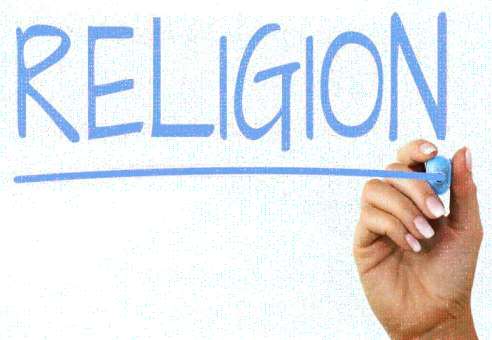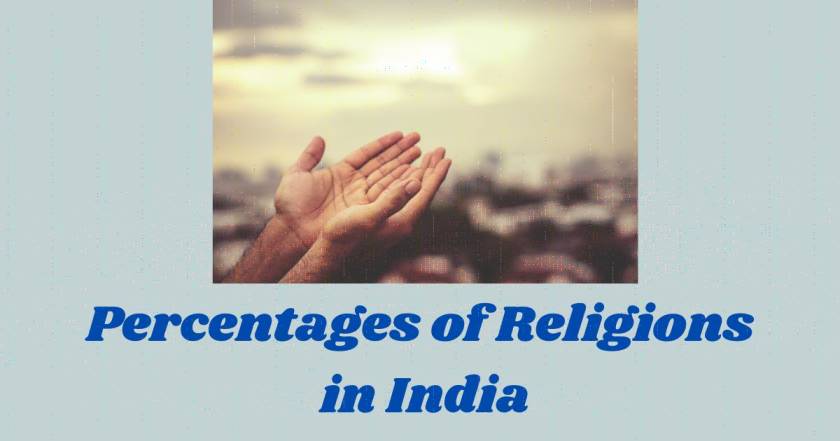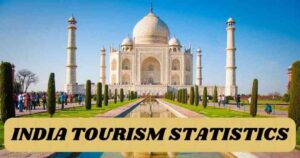Religions in India
Religion is very important in India because it’s a part of the country’s culture and history. India has many different religions that have been around for a long time. These religions include Hinduism, Buddhism, Jainism, Sikhism, Islam, Christianity, and some smaller ones. Each religion has its own beliefs and practices.
People in India respect all religions, and they live peacefully together, no matter what religion they follow. This diversity of religions is what makes India special. It shows that people can get along even if they have different beliefs.
Hinduism, the oldest religion in India, serves as a cornerstone of the country’s spiritual heritage. Its diverse traditions, ranging from Bhakti (devotion) to Vedanta (philosophy), reflect the plurality inherent in Indian spirituality. With millions of gods and goddesses representing various aspects of the divine, Hinduism encapsulates a broad spectrum of beliefs and practices.
Buddhism, originating in ancient India, offers a path of enlightenment through the Four Noble Truths and the Eightfold Path. Its teachings on compassion, mindfulness, and the impermanence of existence have deeply influenced Indian thought and continue to inspire seekers worldwide.
Jainism, another ancient Indian religion, emphasizes non-violence (ahimsa), truthfulness, and non-attachment (aparigraha). Jains strive for spiritual liberation through self-discipline and adherence to a strict code of conduct, fostering a culture of reverence for all living beings.
Sikhism, founded in the Punjab region in the 15th century, espouses the belief in one God and the importance of community service and equality. Sikhs follow the teachings of the Guru Granth Sahib and strive to lead lives of humility, compassion, and devotion.
Islam, introduced to India in the 7th century, has become an integral part of the country’s religious landscape. Indian Muslims, adhering to the five pillars of Islam, contribute to the diverse cultural fabric with their traditions, art, and literature, enriching the nation’s syncretic heritage.
Christianity in India has a rich history dating back to the first century AD, marked by the arrival of Saint Thomas the Apostle. Christianity has flourished in India, particularly in southern regions. Indian Christians, representing various denominations, contribute to the cultural milieu with their distinct religious practices, festivals, and charitable works.
Percentages of Religions in India
Percentages of religions in India are Hindus with approximately 79.8%, Muslims with roughly 14.2%, Christians with about 2.3%, Sikhs with around 1.7%, Buddhists with roughly 0.7%, Jains with about 0.4%, Adivasi religions with approximately 0.5%, and other religions collectively constituting around 0.15% of the population.
The below table represents the religious demographics of India based on data from the 2011 Indian Census. It outlines the distribution of different religious affiliations among the population, expressed as percentages. Below is an explanation of each religious category and its significance.
| Religion | Percentage |
|---|---|
| Hinduism | 79.8% |
| Muslim | 14.2% |
| Christianity | 2.3% |
| Sikhism | 1.7% |
| Buddhism | 0.7% |
| Adivasi (incl. Sarnaism, Bon, Animism, Kirat Mundhum, Donyi-Polo) | 0.5% |
| Jainism | 0.4% |
| No religion (inc. Atheism, Agnosticism, Secularism and Not stated) | 0.25% |
| Others (incl. Baháʼí Faith, Zoroastrianism, Judaism) | 0.15% |
- Hinduism (79.8%): Hinduism is the dominant religion in India, representing nearly 80% of the population. It is one of the oldest religions globally and encompasses a wide range of beliefs, practices, and traditions. Hinduism has deeply influenced Indian culture, society, and politics throughout history.
- Muslim (14.2%): Islam is the second-largest religion in India, constituting approximately 14.2% of the population. Muslims in India have a rich cultural heritage and contribute significantly to the country’s diversity. They have a distinct socio-religious identity and are concentrated in certain regions of the country.
- Christianity (2.3%): Christianity is a minority religion in India, representing around 2.3% of the population. It has a long history in India, dating back to the arrival of St. Thomas the Apostle in the first century AD. Indian Christians are diverse, belonging to various denominations and linguistic groups.
- Sikhism (1.7%): Sikhism originated in the Punjab region of India in the 15th century and is the fourth-largest religion in the country, comprising approximately 1.7% of the population. Sikhs are known for their distinctive identity, including the practice of wearing turbans and maintaining uncut hair.
- Buddhism (0.7%): Buddhism, founded by Gautama Buddha in ancient India, is a minority religion in the country, representing around 0.7% of the population. It has a significant presence in states like Maharashtra, Bihar, and Uttar Pradesh.
- Adivasi (0.5%): Adivasi refers to the indigenous tribal communities of India. They have their unique religious beliefs and practices, often categorized under animism, tribal deities, and nature worship. Adivasi religions contribute to the rich cultural diversity of India.
- Jainism (0.4%): Jainism is an ancient religion that emphasizes non-violence, compassion, and spiritual liberation. Jains constitute a small minority in India, comprising approximately 0.4% of the population. They are known for their strict adherence to vegetarianism and principles of ahimsa (non-violence).
- No Religion (0.25%): A small percentage of the population in India identifies as having no religious affiliation. This category includes atheists, agnostics, secularists, and those who choose not to state their religious beliefs.
- Others (0.15%): The “Others” category encompasses various minority religions in India, including Baháʼí Faith, Zoroastrianism (Parsi), Judaism, and others. While collectively constituting a small percentage of the population, these religions contribute to India’s religious diversity.

Indian Muslim Percentage
| Religion | Percentage | Population (2011) | Projected Population (2024) |
|---|---|---|---|
| Islam | 14.2% | 172,138,476 | 204,760,392 |
With a percentage of 14.2% in 2011, the Muslim community comprised approximately 172,138,476 individuals, making it the second-largest religious group in India after Hinduism. The data also presents a projected estimate for 2024, indicating a growth in the Muslim population to approximately 204,760,392 individuals, based on UN Population data. This figure underscores the steady increase in the Muslim community’s numerical strength over time within the Indian population.
The percentage of Indian Muslims, as highlighted in the table, is a critical metric that offers insights into their demographic presence and significance within the country. At 14.2%, Muslims constitute a sizable minority group in India, contributing to the nation’s cultural, social, and economic fabric. The Muslim community’s numerical strength underscores its importance as a vibrant and integral part of Indian society, enriching the country’s religious and cultural diversity.
The growth of the Indian Muslim population, as evidenced by the projected estimate for 2024, reflects broader demographic trends and patterns within India. The Muslim community’s demographic dynamics are influenced by various socio-economic, political, and cultural factors, including education, healthcare, employment opportunities, and socio-religious practices.
The Indian Muslim population is characterized by its diversity, encompassing a wide range of ethnicities, languages, and cultural traditions. Muslims in India adhere to various sects and schools of thought within Islam, contributing to the community’s rich religious and cultural heritage. They celebrate religious festivals such as Eid al-Fitr and Eid al-Adha, marking the end of Ramadan and the pilgrimage of Hajj, respectively, fostering a sense of unity and solidarity among believers.
The percentage of Indian Muslims serves as a vital indicator for policymakers, researchers, and stakeholders to understand the community’s socio-economic and political dynamics. It highlights the importance of addressing the diverse needs and aspirations of the Muslim community through inclusive policies and initiatives aimed at promoting their socio-economic development and empowerment.
Indian Hindu Percentage
| Religion | Percentage | Population (2011) | Projected Population (2024) |
|---|---|---|---|
| Hinduism | 79.8% | 966,089,301 | 1,150,719,370 |
The data provided offers a comprehensive insight into the demographic representation of Hinduism within the Indian population, delineating its percentage and estimated population figures for both 2011 and 2024. Hinduism, as the predominant religion in India, holds a significant place in the country’s religious and cultural landscape, and the table’s data highlights its numerical strength and growth over time.
In 2011, Hinduism constituted a staggering 79.8% of India’s total population, equating to approximately 966,089,301 individuals. This overwhelming majority underscores the profound influence and deep-rooted presence of Hinduism in Indian society. Hinduism, as one of the world’s oldest religions, encompasses a rich tapestry of beliefs, rituals, and cultural practices that have shaped the ethos of Indian civilization for millennia.
Fast forward to 2024, the projected estimate for the Hindu population in India stands at a formidable 1,150,719,370 individuals. This figure, based on UN population data, indicates a significant growth in the Hindu population over the intervening years. The steady increase in the Hindu population underscores the enduring vitality and resilience of Hinduism as a religious and cultural force in India.
The percentage of Indian Hindus, as depicted in the table, is a crucial metric that reflects the community’s demographic representation within the Indian population. At 79.8%, Hindus constitute an overwhelming majority in India, shaping the country’s socio-cultural, political, and economic landscape. The numerical strength of Hindus influences various aspects of Indian life, including religious practices, festivals, customs, and traditions that are deeply intertwined with Hindu religious beliefs and principles.
The Hindu community in India is characterized by its diversity, encompassing a multitude of regional, linguistic, and cultural variations. Hindus adhere to various sects, traditions, and philosophical schools within Hinduism, contributing to the community’s rich religious and cultural tapestry. Hindu festivals such as Diwali, Holi, Navratri, and Durga Puja are celebrated with great fervor and enthusiasm across the country, fostering a sense of unity and cultural pride among Hindus.
Indian Christian Percentage
| Religion | Percentage | Population (2011) | Projected Population (2024) |
|---|---|---|---|
| Christianity | 2.3% | 27,918,662 | 33,215,237 |
The provided data offers valuable insights into the demographic representation of Christianity within India, encapsulating its percentage and estimated population figures for both 2011 and the projected estimate for 2024. Christianity, as a minority religion in India, occupies a distinctive place within the country’s diverse religious landscape, and the data underscores its numerical presence and growth trajectory over time.
In 2011, Christianity constituted a modest 2.3% of India’s total population, representing approximately 27,918,662 individuals. Despite being a minority religion, Christianity has a rich and diverse history in India, with roots that trace back to the arrival of St. Thomas the Apostle in the first century AD. Over the centuries, Christianity has flourished in various regions of India, influenced by interactions with indigenous cultures and traditions.
Fast forward to 2024, the projected estimate for the Christian population in India stands at an estimated 33,215,237 individuals, based on UN population data. This figure suggests a notable increase in the Christian population over the intervening years.
The percentage of Indian Christians, as depicted in the data, serves as a critical metric that highlights the demographic representation of the Christian community within the Indian population. At 2.3%, Christians constitute a minority religious group in India, contributing to the country’s religious and cultural diversity. Despite their relatively small numerical presence, Christians in India have made significant contributions to various aspects of Indian society, including education, healthcare, social welfare, and cultural enrichment.
The growth of the Christian population in India is influenced by various factors, including historical legacies, missionary activities, social dynamics, and economic opportunities. Christianity’s emphasis on education, healthcare, and community development has contributed to its growth and influence in certain regions of India, particularly in areas where missionary efforts have been concentrated.
The Christian community in India is characterized by its diversity, encompassing a wide range of denominations, traditions, and cultural practices. Christians in India come from various linguistic, ethnic, and socio-economic backgrounds, contributing to the rich tapestry of Indian society. They celebrate religious festivals such as Christmas, Easter, and Good Friday, alongside indigenous festivals that reflect their cultural integration with local communities.
Despite facing challenges such as social discrimination, communal tensions, and legal restrictions in certain contexts, Indian Christians continue to actively participate in nation-building efforts and advocate for social justice, religious freedom, and interfaith harmony. Their contributions to education, healthcare, social services, and cultural preservation have left an indelible mark on Indian society.
Disclaimer: The data research report provided here is sourced from various channels, aiming for accuracy but unable to guarantee every detail’s absolute precision. It is intended for informational purposes only, and users are urged to verify critical information independently before making decisions. We are not liable for any financial loss, errors, or damages arising from the use of this information. While our team strives for accuracy, the dynamic nature of data means we cannot verify every fact. Your understanding and discretion are valued.







